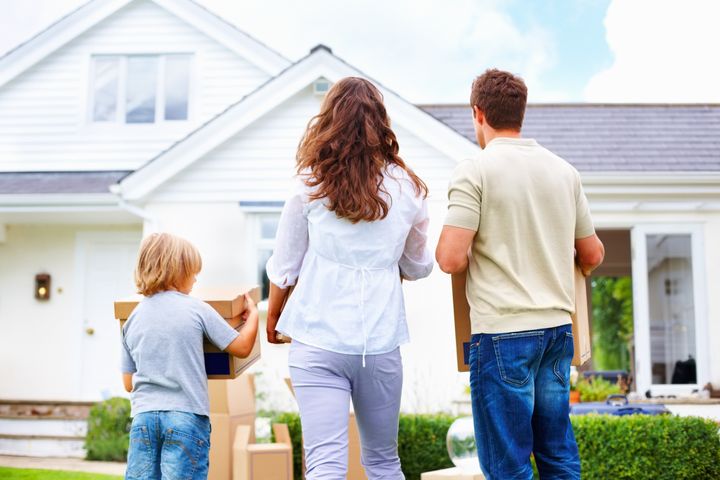
Today is Earth Day, a time to reflect on our environmental impact and consider shifts toward healthier and more sustainable living. But today I'm not thinking about litter on the side of highways or rapidly depleting rainforests -- my thoughts are with a woman named Nicki and her two little girls in Portland, Ore.
A few years ago, Nicki and her family lived in a rundown apartment. Their walls were discolored and covered with mold, causing her daughters to wheeze and cough. When her kids had trouble sleeping, Nicki would hold them close and pray for them to start breathing normally, a desperate feeling any mother can sympathize with.
For years Nicki and her husband searched for a cleaner and safer home, but all available options were outside their modest budget. Even in their aging apartment Nicki struggled to cover the steep heating and electricity bills, leaving little for food and other necessities.
That all changed when the Nicki and her family moved to Oleson Woods, a green affordable housing development in southwest Portland. Apartments at Oleson Woods are rented out at below-market rates affordable to low- and moderate-income families and equipped with cutting-edge air and ventilation systems, as well as cost-saving lighting and water fixtures.
"Since we moved here, we've all been so much healthier," Nicki said a few months after finding her new home."Every day, I'm like, 'Thank you, thank you, thank you.' Living here has been so positive for my family," she said.
Nicki's story is not unique. It's an example of the critical but often overlooked link between green building, affordable housing and long-term health.
Today 5.7 million families in the U.S. live in substandard housing, with problems like insufficient heating and plumbing, cracked walls and windows, leaking roofs and vermin infestations. Research shows that children living in unfit housing have higher risks for asthma and other respiratory illnesses, cardiovascular health problems, headaches, increased stress and overall physical and mental health issues. All told, about 40 percent of childhood asthma diagnoses are tracked back to exposures in homes.
Those health problems place a significant burden on our health care system. The Centers for Disease Control estimates that health care costs related to asthma alone add up to more than $50 billion each year.
That's why some pediatricians, such as Dr. Megan Sandel and Dr. Deborah A. Frank of Children's HealthWatch, consider housing a "vaccine." The doctors wrote in 2011 that a safe and stable home "literally keeps children healthy."
Preliminary data back that up. Several years ago, Enterprise partnered with the National Center for Healthy Housing to track health outcomes of residents of a Minnesota apartment building before and after green rehabilitation. Families reported substantial improvements in hypertension, chronic bronchitis, hay fever, asthma and sinusitis. (That's in addition to significant long-term cost savings from lower energy consumption.)
In another study from 2011, the King County Health Department found that asthmatic children in Seattle public housing experienced a 44 percent increase in symptom-free days and a 66 percent reduction in the use of urgent clinical care after moving into greener, healthier apartments.
These case studies, like Nicki's story, give us plenty of anecdotal evidence of the healing power of green homes, but we're yet to see a paradigm shift toward healthier building. Part of the problem is a lack of information -- we simply don't have comprehensive data on the health, economic, environmental and other benefits of green affordable housing.
Starting next month, Enterprise Community Partners, with support from the JPB Foundation, the Kresge Foundation, Wells Fargo and technical guidance from the Mount Sinai School of Medicine, will begin a seven-year study of the overall effects of green housing renovation on health outcomes. We'll collect data on families, buildings and surrounding communities in three cities -- New York, San Francisco and Cleveland -- to paint a comprehensive picture of the link between housing, environmental sustainability and long-term health.
Equipped with better evidence of the costs and benefits, it will be easier to transform the practices of housing developers and convince policymakers to support, require or incentivize the expansion of green affordable housing.
When a small group of activists organized the first Earth Day in 1970, they described it as "a commitment to make life better, not just bigger and faster." That's precisely what green, affordable homes did for Nicki and her family in Portland, for dozens of low-income families in Minnesota and for families in public housing in Seattle -- it made life better. It's time we extended the same health, economic and environmental benefits to all low-income families.
Terri Ludwig is the President and CEO of Enterprise Community Partners, a leading national provider of the development capital and expertise it takes to create decent, affordable homes in thriving communities.
